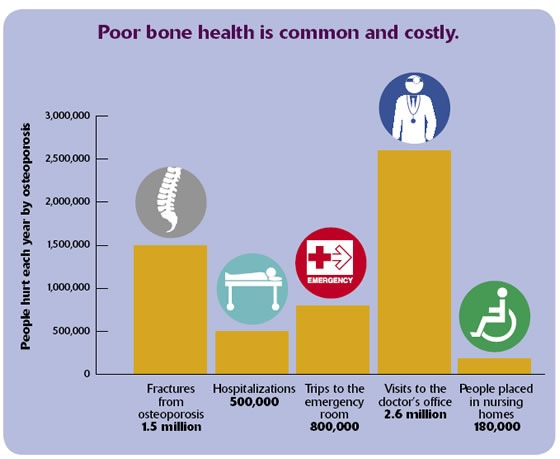Bone disease is a condition that damages the skeleton and makes bones weak and prone to fractures. Weak bones are not a natural part of aging. While strong bones begin in childhood, people of all ages can improve their bone health.
The most common bone disease is osteoporosis, which is characterized by low bone mass and deterioration of bone structure. Osteoporosis can be prevented, as well as diagnosed and treated. Low bone mass is when bones lose minerals, like calcium, that make them strong, and as a result, bones become weak and fracture easily. Fractures to weak bones typically occur from falling or other common accidents.
Other bone diseases include Paget's disease and osteogenesis imperfecta. Paget's disease affects older men and women, and causes skeletal deformities and fractures. Osteogenesis imperfecta is an inherited disorder that causes brittle bones and frequent fractures in children.
A healthy skeletal system with strong bones is essential to overall health and quality of life. Strong bones support our body; protect our heart; lungs and brain from injury; and are the framework for muscles that allows us to move. Bones are also a storehouse for life-supporting minerals. 
Osteoporosis and other bone diseases, such as Paget's disease and osteogenesis imperfecta, can lead to a downward spiral in physical health and quality of life including losing the ability to walk, stand, and dress. It can even lead to premature death. Weak bones can result in painful and debilitating fractures. Each year, 1.5 million Americans suffer a fracture because of weak bones. The most common breaks are of the wrist, spine and hip.
Hip fractures are by far the most devastating type of broken bone and account for almost 300,000 hospitalizations each year. Of hip-fracture patients: 20 percent die within a year of the fracture, and 20 percent end up in a nursing home within a year. Many become isolated, depressed or afraid to leave home because they fear falling.
Bone disease is costly for society and individuals with the disease. In the United States, care for bone fractures from osteoporosis costs nearly $18 billion each year. The cost from a hip fracture for one individual can be more than $81,000 during their lifetime.
Many Americans do not know that their bone health is in jeopardy. Osteoporosis is a silent disease until fractures occur. Four times as many men and nearly three times as many women have osteoporosis than report having the disease. The number of hip fractures in the United States could double or even triple by 2040. Bone disease affects women and men of all ethnicities, although the risk of bone disease is highest among women. Bone disease is a real risk for any man or woman at any age.
Further Reading